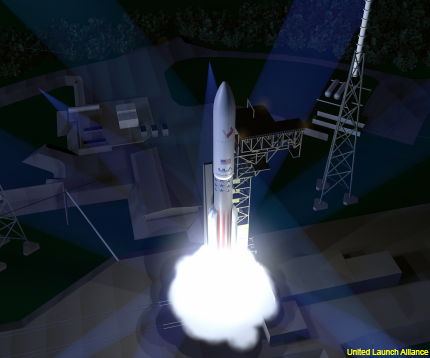Reusable rocket race heats up with Vulcan
ULA rolls out a new U.S. rocket with reusable components, while SpaceX again narrowly fails to recover a spent launcher.

An artist's rendition of ULA's next-generation Vulcan rocket.
The United States moved a step closer to assuring cheaper access to space this week, as one commercial space company rolled out a new workhorse launcher that includes reusable components while another company had another near-miss attempt to recover a commercial launcher.
For starters, United Launch Alliance unveiled its Next Generation Launch System at the annual Space Symposium in Colorado Springs. The new rocket, dubbed Vulcan, would replace ULA's Atlas and Delta rockets now used to loft most military payloads. Vulcan would be powered by a U.S.-made BE-4 rocket engine currently under development with commercial startup Blue Origin.
The partners are competing for military launch contracts under the Air Force's Evolved Expendable Launch Vehicle program. The BE-4 engine, which uses cheaper liquefied natural gas fuel and is designed for reuse, would replace Russian RD-180 engines currently used in Atlas V launches.*
ULA CEO Tory Bruno also said the Vulcan would incorporate a modular approach that would enable reuse of the booster main engines, the most expensive component on the first stage. ULA is proposing "mid-air capture" technique to recover Vulcan’s first stages, which would then be refurbished for later flights.
Space Exploration Technologies Corp., meanwhile, has twice launched a rocket designed to be reusable but so far has suffered near-misses in its attempts to recover the spent first stages. The latest failure came this week when a spent Falcon 9 rocket boosting a cargo ship to the International Space Station found its target, a floating platform in the Atlantic Ocean off the Florida coast, but tipped over after touchdown. SpaceX founder Elon Musk said via Twitter that excessive lateral motion as the rocket settled onto the floating platform caused it to fall over and explode.
Both ULA and SpaceX are attempting to reduce the high cost of expendable rockets as they compete for commercial and military launch contracts. Much of SpaceX's success hinges on its ability to leverage computer-aided engineering tools in rocket design in order to reduce the cost of lifting a pound of payload to orbit. For the commercial space industry, the Holy Grail for launch costs is about $1,000 per pound to orbit. That goal remains elusive, but the Air Force is willing to pay more to assure access to space.
Nevertheless, ULA is straining to match high-profile efforts by rival SpaceX to reduce launch costs. Along with a reusable main engine, Bruno said the new Vulcan initiative would eventually include a new upper stage that would replace the current Centaur second stage. ULA said the new Advanced Cryogenic Evolved Stage would be capable of executing "almost unlimited burns" that the company claimed could extend on-orbit operating time from hours to weeks.
Here’s an animated video of Vulcan being launched.
Most upper stages are fired only once before they are discarded. Among the few upper stages that could be fired more than once was the Saturn S-IVB third stage engine that boosted American astronauts to orbit and then to the moon in the late 1960s and early 1970s.
Bruno added that the combination of Vulcan's new second stage engine with the BE-4 main engine would match the lifting capacity of the current Delta IV Heavy rocket.
The Vulcan rocket is scheduled to make its maiden flight in 2019.
* An earlier version of this story incorrectly stated that the RD-180 was used in both the Atlas V and Delta IV rockets. It's used only with the Atlas V. The Delta IV uses Aerojet Rocketdyne's RS-68.
NEXT STORY: An unexpected source of mobile security: Ada



